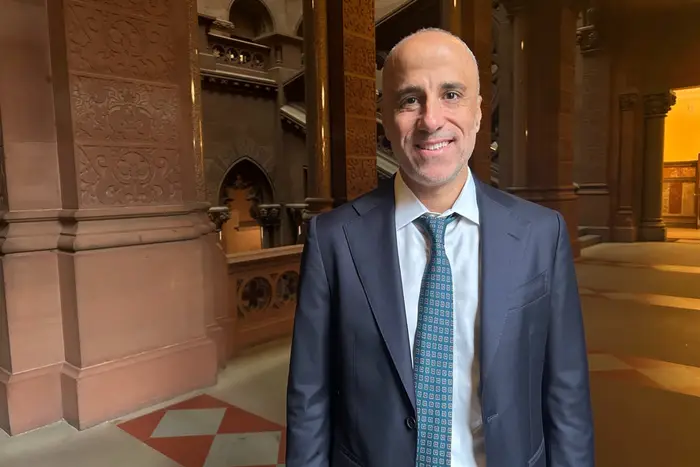Drew Warshaw Challenges DiNapoli for New York Comptroller Role

Drew Warshaw, a newcomer in the political arena, is positioning himself as a challenger to current New York State Comptroller Tom DiNapoli in the upcoming Democratic primary. Warshaw recently showcased an oversized check for $21 million near Wall Street, symbolizing the fees that the New York state retirement fund pays to money managers. He argues that DiNapoli should adopt a more proactive approach to the state’s affordability crisis, aiming to infuse new energy into an office that wields significant influence yet often receives little public attention.
Warshaw seeks to transform the role of the comptroller, which oversees the New York State Common Retirement Fund, a substantial investment pool valued at approximately $284 billion. He emphasizes the critical nature of how this money is invested, highlighting its potential impact on taxpayers. “To have the opportunity and the power to attack the affordability crisis head-on is a dream job,” Warshaw stated, advocating against the notion of lifetime appointments for such positions.
DiNapoli, who has held the position since 2007 and is campaigning for a fifth term, defends his record as a steady hand in the office. “Given all the challenges out there, all the polarization, I think [it’s important] to have a steady hand in this very important office,” he remarked. While acknowledging that the role may not be glamorous, he insists its functions are vital to state government.
Warshaw proposes a bold initiative, suggesting that $10 billion of the pension fund be allocated to affordable housing projects throughout the state. With previous experience working for former Governor Eliot Spitzer and leading companies in solar power and affordable housing, he claims his plans are grounded in real-world experience. “We can get a strong rate of return for the pension fund and still invest in homes that New Yorkers can afford,” he said.
Current disclosures indicate that about 14% of the pension fund’s holdings are in real estate, including some affordable housing projects. However, DiNapoli contends that the specifics of these investments are not disclosed, and he views Warshaw’s focus on affordable housing as a mere talking point. He asserts that the primary goal of the fund is to ensure long-term financial gains for public employees, who benefit from a traditional, defined-benefit pension system.
To maintain these promised payments, state and local taxpayers contribute annually to the fund. Yet, DiNapoli has increased the allocation toward private equity and real estate investments since taking office. He argues that such diversification is essential, particularly during market downturns, as private equity can provide stability to overall returns.
Warshaw counters this perspective by highlighting the financial burdens that high fees impose on taxpayers. The pension fund reportedly paid around $1.1 billion in fees to investment managers in the 2024 fiscal year. He criticizes the reliance on complex investments like private equity, suggesting they yield higher fees than traditional stocks or mutual funds. “He’s paying all of these fees that the taxpayers fund through income taxes and property taxes to a bunch of Wall Street bankers to try and beat the market,” Warshaw claimed, arguing that DiNapoli has underperformed against his own benchmarks.
DiNapoli defends his record, noting that valuing private-equity holdings can be challenging, as these investments often take years to mature. Between 2015 and 2025, the pension fund has achieved an average annual return of 7.74%, slightly above the national average of 7.4% for public pension plans, as calculated by Boston College. In comparison, the S&P 500 Index recorded an average return of approximately 10.7% during the same period.
While DiNapoli describes his long-term target return of 5.9% as conservative and responsible, Warshaw argues that it is inadequate and detrimental to taxpayers. As the primary elections approach, the debate between these two candidates highlights critical issues surrounding fiscal management and the future of the New York State retirement fund.






